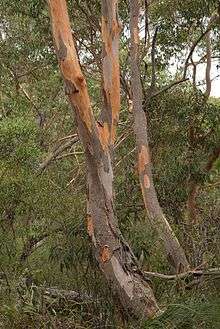Eucalyptus punctata
| Grey gum | |
|---|---|
 | |
| Scientific classification | |
| Kingdom: | Plantae |
| Clade: | Angiosperms |
| Clade: | Eudicots |
| Clade: | Rosids |
| Order: | Myrtales |
| Family: | Myrtaceae |
| Genus: | Eucalyptus |
| Species: | E. punctata |
| Binomial name | |
| Eucalyptus punctata | |
| Synonyms | |
|
Eucalyptus shiressii Maiden & Blakely | |
Eucalyptus punctata, commonly known as grey gum, is a large tree of the myrtle family, Myrtaceae, native to South East Queensland and eastern New South Wales, where it specialises in poor soils such as Sydney sandstone. Its leaves are one of the favoured foods of the koala. The tree's common name comes from its bark, which takes a greyish cast at about one year of age (see photograph). On most trees this bark is partly shed, revealing a bare and slightly orange or brown tinted smooth surface. The white flowers appear over the summer.
Taxonomy
Swiss naturalist Augustin Pyramus de Candolle first described the grey gum in 1828. Common names include grey gum and grey irongum.[1] The species name is the Latin adjective punctata "spotted" and refers to the oil glands which give the leaves a dotted appearance.[2]
It is one a group of related species known collectively as large-fruited grey gums found in eastern Australia, the others being E. longirostrata from eastern Queensland, E. biturbinata from the New England region, and E. canaliculata from the vicinity of Gloucester and Dungog in central-northern New South Wales.[2]
Description
The grey gum grows as a large tree to 35 m (115 ft) high, with bark of various shades of grey, white and orange hues, which sheds in large sheets, giving the trunk a patchy appearance. The glossy dark green adult leaves are falcate (sickle-shaped) or lanceolate and measure 8–15 cm (3–6 in) in length by 1.5–3 cm (0.59–1.18 in) wide. The flowers are white,[3] and are in bloom from December to March.[4]
Distribution and habitat
The range is from the Liverpool Range to Nowra in central New South Wales, most commonly on transition zone soil type between sandstone and shale.[2]
It grows in tall open sclerophyll forest, associated with such species as red bloodwood (Corymbia gummifera), pink bloodwood (C. intermedia), spotted gum (C. maculata), white stringybark (E. globoidea), sydney peppermint (E. piperita), blackbutt (E. pilularis), yellow box (E. melliodora), mountain grey gum (E. cypellocarpa), narrow-leaved ironbark (E. crebra), grey ironbark (E. paniculata), broad-leaved white mahogany (E. umbra), white mahogany (E. acmenoides), and apples (Angophora species).[2][5]
Ecology
The grey gum regenerates by regrowing from the base and branches after bushfire. Trees live for over a hundred years. The grey-headed flying fox (Pteropus poliocephalus) eats the flowers, while the leaves form a staple of the diet of the koala (Phascolarctos cinereus).[5] Leaves in winter contain less nitrogen than those in summer, which the koalas make up for by eating more in winter months.[6] The brown-headed honeyeater (Melithreptus brevirostris) and yellow-tufted honeyeater (Lichenostomus melanops) have been observed eating gum exudate from the stems.[7] Fieldwork at several sites around central New South Wales showed that the red wattlebird (Anthochaera carunculata) and noisy friarbird (Philemon corniculatus) preferred to forage on the foliage of the grey gum over other trees, with the former appearing to oust the latter if both species were present.[8]
Uses
The timber is very hard and durable, and used in construction and for railway sleepers.[2] The multicoloured bark of Eucalyptus punctata that appears from time to time gives the tree some horticultural appeal, and it has potential applications in large parks, reserves and fields.[9]
References
- ↑ "Eucalyptus punctata DC". Australian Plant Name Index (APNI), IBIS database. Centre for Plant Biodiversity Research, Australian Government.
- 1 2 3 4 5 Boland Douglas J.; Brooker M. I. H.; Chippendale G. M.; McDonald Maurice William (2006). Forest trees of Australia. Collingwood, Victoria: CSIRO Publishing. p. 306. ISBN 0-643-06969-0.
- ↑ "Eucalyptus punctata". EucaLink: A Web Guide to the Eucalyptus. Royal Botanic Gardens, Sydney. Retrieved 2 September 2011.
- ↑ Fairley Alan; Moore Philip (2000). Native Plants of the Sydney District:An Identification Guide (2nd ed.). Kenthurst, NSW: Kangaroo Press. p. 211. ISBN 0-7318-1031-7.
- 1 2 Benson, Doug; McDougall Lyn (1998). "Ecology of Sydney plant species:Part 6 Dicotyledon family Myrtaceae" (PDF). Cunninghamia. 5 (4): 809–987. Archived from the original (PDF) on 2009-06-14.
- ↑ Cork, S. J. (1986). "Foliage of Eucalyptus punctata and the Maintenance Nitrogen Requirements of Koalas, Phascolarctos cinereus". Australian Journal of Zoology. 34 (1): 17–23. doi:10.1071/ZO9860017.
- ↑ Barker RD, Vestjens WJ (1984). The Food of Australian Birds: (II) Passerines. Melbourne University Press. ISBN 0-643-05115-5.
- ↑ Saunders Anthony S. J; Burgin Shelley (2001). "Selective foliage foraging by Red Wattlebirds, Anthochaera carunculata, and Noisy Friarbirds, Philemon corniculatus". Emu. 101 (2): 163–66. doi:10.1071/MU00007.
- ↑ Elliot Rodger W.; Jones David L. (1986). "Eu-Go". In Elliot, Rodger W.; Jones, David L. Encyclopaedia of Australian Plants suitable for cultivation. 4. Lothian Publishing. p. 190. ISBN 0-85091-213-X.